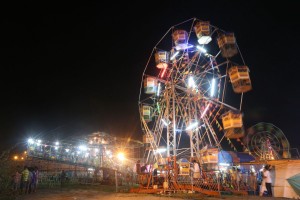If one wants to be ‘legit’ and local about using fireworks on New Year’s eve, go to the South Road Properties (SRP) in Cebu City.
Ask Rafaella Rabor, an 83-year-old veteran in the business, one of scores of vendors in temporary booths set up by the Cebu city government, which opens the sale area every Christmas season until the Sinulog.
Resting her elbow on large coils of Judas Belt firecrackers piled on a table, Rabor said she wasn’t happy with her Christmas sales so far and hopes the New Year celebration will make up for the slack.
She perked up when asked to show her favorite merchandise and explain how they worked.
She pointed to the most expensive one, the “100 Shots” which comes in a carton about the size of two shoe boxes.
It’s safe, she said, and produces beautiful effects in the night sky.
The pyrotechnic shoots 100 whistling missiles into the sky and explodes with intricate sparks that form mushrooms, stars, and smileys, and other designs.
VETERAN VENDOR
Rabor has been in the business for 16 years, and is an old acquaintance of the Pongasi family, the original fireworks makers in Lapu-Lapu City.
For the past five years, however, the Cebu city government has declared the SRP the designated zone for selling pyrotechnics and firecrackers.
The wide open grounds far from populated areas make it easier to regulate and reduce fire hazards.
Before that, Rabor was a favorite source of street vendors in downtown Cebu City because of her low prices.
But rather than play hide-and-seek with the police, she joins the annual SRP fair.
Vendors who sell outside the SRP risk having their goods confiscated by law enforcers and being penalized for violation of a city ordinance and Republic Act 7183, the national law regulating the sale, manufacture, distribution and use of firecrackers and other pyrotechnic devices.
When Rabor started in the business, she sold simple firecrackers during the holiday season in her sari-sari store in barangay Labangon, Cebu City. The small store is the family’s main source of livelihood and supports her seven children.
In her small booth at SRP, Rabor attends to customers with one assistant, her daughter Elsie Romarate, 55.
The 100 Shots she recommended comes in different sizes with the most expensive one costing P2,500 per box . These are manufactured in Bulacan province, the pyrotechnics “capital” in Luzon.
She said a newer local version called “Bomb Shells” is made in barangay Babag, Lapu-Lapu City.
It’s just as beautiful, said Rabor, with bigger light displays in the sky, and a distinctive blast like a bomb. It comes with a meter-long tube that the user has to mount on the ground to explode the “bomb” safely.
Bomb Shells are sold in sets of five at P1,200. Each piece looks like Cebu’s famous “puso” or woven pouch of hanging rice with a wick at one end that is lighted while the pyrotechnics is placed inside the tube.
Rabor said she and other SRP vendors don’t sell foreign brands. These are mostly made in China and found in malls and department stores.
Rabor’s two favorite products, however, aren’t bestsellers because of the steep price.
A more popular and affordable choice among buyers are varying lengths and sizes of Judas Belt firecrackers, Luces, sparklers, Fountains, and “kwitis” or small firecrackers.
The Judas Belt has firecrackers of varying sizes attached to each of its strands like a bandolier.
The bigger the size, the louder the bang.
SAFETY MEASURES
The fireworks stalls are located near the SRP shoreline on a wide vacant lot behind the Sugbo Building. Each stall is about seven square meters and has a specified distance from each other for safety.
Drums of water are placed beside each stall as a precaution against fire accidents. “No smoking” signs are posted prominently around the area.
The vending area is about 100 meters away from the Kasadya sa SRP, a carnival and outdoor dining area.
Rabor’s daughter Elsie said caution is needed in firing up a Judas Belt.
Choose an open space on the ground, far from people.
“Ibutang lang na nimo diha sa dalan. Safe ra gyud na ,” Elsie added.
(Put it on the road. It’s safe to use.)
Every year, hospital emergency rooms go on special alert to attend to victims of burns and accidental explosions, either users of fireworks or bystanders.
Elsie said their business may be dangerous, but they never had accidents with their merchandise because they see to it that stocks are kept in a safe place. No one is allowed to smoke near them, she said.
Rabor said that her sari-sari store caught fire three years ago which had spread from a neighbor’s house, but her fireworks were not the cause of the blaze.
Every year has brought profitable sales, said Rabor, except this year with two calamities in the Visayas – the October 15 earthquake and supertyphoon Yolanda in November 8.

PASKO SA SRP. A trip to the carnival is a cool alternative to malling and Christmas partying. (Tonee Despojo)
Disclaimer: The comments uploaded on this site do not necessarily represent or reflect the views of management and owner of Cebudailynews. We reserve the right to exclude comments that we deem to be inconsistent with our editorial standards.
